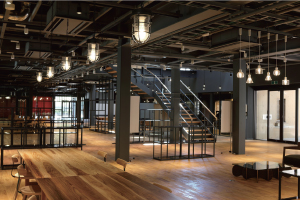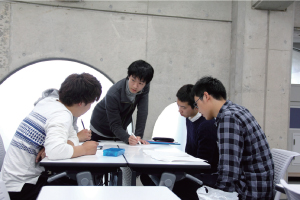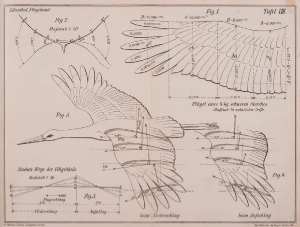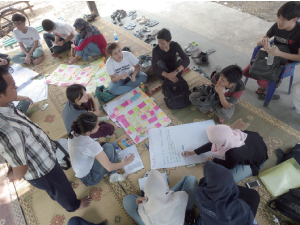About KIT
Message from the President
Co-creation education through intergenerational, interdisciplinary and intercultural activities that make innovation possible

Now that science and technology have become diversified, and it is difficult to predict what will happen in the future, there is a demand for personnel with a talent for “technical innovation” that will enable Japan to continue to develop as a world leader in science and technology.
In response to this societal demand, KIT provides education based on our policies of “Ideal character building”, “Further technical innovation” and “Superb academic-industrial cooperation” to produce engineers who have Ningenryoku and strength as innovators, and who will think and act for themselves.
KIT is a place where students challenge themselves to develop technology that is useful for society through understanding other’s standpoints, collaborating and testing their ingenuity. Its most characteristic feature is project-based practical education referred to as “Project design education.” This type of education allows students to identify problems of social value and explore measures to solve them.
We incorporate “Intergenerational, interdisciplinary and intercultural co-creation education” into our lessons, projects and research, which involve the participation of researchers, engineers, local residents and people from other countries.
Students study, research and carry out their projects with people of different generations, fields and cultures. They gain the following advantages:
- The research skills to take on the challenges of the future
- A combination of academic skills and human strength that creates overall competence
- Readiness for a globalized society
Building overall competence through the regular curriculum (academic skills) and extracurricular activities (human strength)

Our Yume-kobo Robot Project won first place in the 2013 Asia-Pacific Robot Contest. More than 100 extracurricular projects are being carried out at KIT.
KIT features Project Design education, in which students identify and solve problems in teams. In 2011, we became the first Japanese university to join the CDIO Initiative (Conceive, Design, Implement and Operate). It is the universal standard for engineering education, and is adhered to by more than 130 organizations in 36 countries, including MIT and Stanford University.
Students are requested to find what users need and to embody their solution as a prototype. Through a process of experiments, validation and evaluation, they acquire the “innovation skills” that are required of personnel who will play an important role in the global society.
In 2016, we launched an e-syllabus to combine more than 100 extracurricular projects and the regular curriculum for the purpose of building overall competence. In April 2017, our new “Yume-kobo” building, which houses a workshop with various types of equipment, and a spacious work area for embodying ideas, was opened. We are promoting CDIO in both our regular curriculum and our extracurricular activities.
Topic: Environment for prototyping, demonstration experiments and social implementation
The new Yume-kobo, a base for manufacturing, was completed in April 2017. Its area is 1.7 times greater than it was previously, and it is equipped with metallic and resin 3D printers, workshops for manufacturing electronic substrates, and booths for processing metal, resin and wood. It also has meeting rooms and a large trial-run track.
With its 15 laboratories and advanced research equipment, Yatsukaho Research Campus allows students to put form to, experiment with, and prove their hypotheses and theories established through research carried out in the undergraduate and master’s courses.
There is also Hakusan Campus, which is a campus for demonstration experiments, and a base for interdisciplinary innovation projects for regional creation using AI, IoT, big data, robots, etc. The research results can be used for social implementation and demonstration experiments.

Left : “Yume-kobo 41” – a base for manufacturing with freedom
Center : Yatsukaho Research Campus, with 15 KIT laboratories
Right : Hakusan Campus is a campus for demonstration experiments and social implementation.
Topic: Started IBM Watson, AI-assisted education for the first time in Japan
KIT was the first Japanese university to introduce IBM Watson, an AI-assisted education service. An academic adviser with artificial intelligence, referred to as “KIT COG,” searches over one million items in the archival records of KIT graduates to select a student with a similar academic background and give appropriate advice to the student based on the data taken from the record. It is possible to provide students with timely advice with regard to their curriculum and extracurricular activity choices.
Intergenerational, interdisciplinary and intercultural co-creation education

Challenge Labo is a place where students of all departments can access new technology such as AI, IoT, big data and data science.
Active learning is becoming increasingly popular. At Japanese universities, students have tended to have discussions with students of the same generation, despite the fact that in the real world they have to carry out projects with people of different specialties and ages. Finding out the opinions and ideas of different types of people is fundamental for the creation of innovation.
KIT’s co-creation education involves the promotion of intergenerational communication with engineers and researchers, interdisciplinary communication with people in different fields, and intercultural communication with people from abroad, including international students, to cultivate a multifaceted viewpoint and create innovation.
We invite engineers from companies and personnel from the municipal government to Project Design classes. In 2018, we changed the organization of project teams from department-based to interdisciplinary teams so that students can have discussions with members of different backgrounds while keeping in mind their own specialty. Our Cluster Research Laboratory became fully operational in 2017. The participation of company engineers allows projects to be more relevant, like actual technical development in the real world. In July 2017, “Challenge Labo” opened on Ohgigaoka Campus as a base for these activities.
Topic: Teaching one’s area of expertise to others is the best way to learn.

KIT emphasizes the fundamental idea that teaching is learning, which is derived from the Chinese “Book of Rites”. To teach someone, one must have several times more knowledge than the learner in order to teach in a way that is easy to understand. Teaching is the best way to deepen one’s learning.
KIT’s students are taught in such a way that they gain the ability to teach what they have learned. Active learning that involves students teaching each other has been incorporated into all subjects since 2016. Students teach their areas of expertise to each other in self-learning sessions at “learning squares” located all over the campus, which are available for use at night as well as in the daytime.
Leaning the essence of science to take on the challenges of the future

Left: Galileo Galilei
Dialogue on the two chief world systems of Ptolemy and Copernicus
Firenze, 1632, Original edition, Collection of KIT
Right : Isaac Newton
Principia (Mathematical Principles of Natural Philosophy)
London, 1687, Original edition, Collection of KIT
At KIT we believe it is through the integration of various scientific disciplines that we can achieve the innovations to transform the way we lead our lives in the future. Such innovations can only emerge once we have truly understood and reflected on the fundamentals of our scientific traditions.
KIT has collected 2,000 seminal works of scientific enquiry in their original editions. Education and research using original editions will start at Challenge Labo. Galileo looked up at the sky and asked himself, “Why don’t the stars fall down from the heavens?” Reflecting on such fundamental questions led him to design and manufacture the first telescope to observe the sky.
In the original edition of Newton’s ground-breaking work Principia, he presents the theory of the Three Universal Laws of Motion derived from geometry and various experiments in writing rather than by means of mathematical formulae.
Students are given the opportunity to read the words of the masters, such as Galileo and Newton, in their original editions, and then design and manufacture the experimental devices described by them. This is to help them understand the processes that lead to scientific breakthroughs and innovation.


Otto Lilienthal
Birdflight as the Basis of Aviation
Berlin, 1889, Original edition, Collection of KIT
The Wright brothers were inspired by this book. If we understand the principle of why birds can fly, the development of a new type of airplane is no longer a dream.
KIT possesses the drawings of the Eiffel Tower, which was completed in 1889. What do the students who are studying architecture and construction materials think of these drawings? While considering the relation between a rational form based on mechanics and beauty, and designing a tall building with an innovative design, using cutting-edge composite materials, students design and manufacture miniatures by means of a 3D printer at Challenge Labo.
There are many research projects that were not carried out in the past due to technological limitations and a lack of experimental accuracy. What did the masters of scientific technology think and talk about? What did their theories and discoveries bring to the future, and how did they change our lives?
With the help of new technology that was unavailable at the time, students may be able to come up with new approaches and advances in theory and practice based on innovation.
Accelerating intercultural co-creation education allows students to respond to global needs.

English course in the Project Design subjects
Recently, KIT’s Project Design education has been attracting the attention of ASEAN countries, and more and more overseas teachers have been coming to KIT to study our method of education. A favorable outcome has been reported by the educational institutions where our method has been incorporated. KIT aims to make our campus a site of collaboration and co-creation among people of different cultures.
English for science and engineering is incorporated into the lessons. Our president’s speech was given in English for the first time this year at the first “Basic Study” class, which was held immediately after the entrance ceremony. In some specialty subjects, test questions are given in English. There is a new English course in the Project Design subjects, and many students are actively learning English in class. We aim to introduce English for science and engineering into 50% of our classes by 2020. However, when we teach a new concept to students, we teach it in Japanese to ensure that they can understand it. In addition, an English glossary that includes basic specialized terms and frequently used expressions is open to the public on the e-syllabus to support self-study.
We have a Buddy System according to which KIT students and international students form a pair and participate in an internship in Japanese companies and International Cooperative Education to build the communication skills that are required in the global society. We will start the Dual Degree Program with Rochester Institute of Technology (RIT), New York, one of the top graduate schools of engineering in the U.S., in 2018. Students majoring in Information Technology in the Master’s Course of KIT Graduate School will be able to obtain a Master’s degree in two years by attending the classes of both universities and meeting the requirements for completion of the program. In addition to being useful for students, these programs prove that KIT’s coursework quality is highly evaluated.
The 2018 International CDIO Conference, with the theme of Innovations in Engineering Education, was held at KIT Ohgigaoka Campus from June 28 to July 2, 2018. The conference offered various programs related to engineering education, including keynote lectures, presentations and workshops. We were able to promote engineering education through interaction with universities belonging to CDIO.
Topic: “Learning Express” — finding and solving problems as part of a multinational team

After compiling information obtained through fieldwork, students discuss the nature of the problem and how it can be solved.
“Learning Express” is a global and social innovation program to develop global human resources. Students with different specialties, languages and cultures work together in multinational teams in Asian villages to identify issues related to local development, environmental problems, and building a sustainable society. They build prototypes to put their ideas into practice and find solutions to problems, which they propose to members of the local community. Students are required to find solutions that are feasible, and to take the local residents’ level of technical skill into consideration.
To solve local problems, KIT is promoting the Learning Express project. This project functions as a stronghold for working together in multinational teams; not only are students sent to other parts of the world, but also students are invited to our campus from other parts of the world.